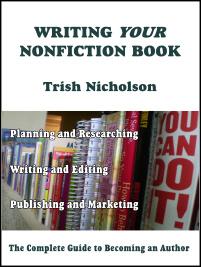By Nora Vasconcelos

Have you ever felt lost while wandering into the writing jungle? Fear no more! Despite the topic you’ve chosen, the path can be clear and easy thanks to Trish Nicholson, author of Writing your Nonfiction Book, published by Collca.
At the begining of her book, she presents a great example from literature that reflects some of the problems writers face. Recalling Charles Dickens David Copperfield, Trish refers to Mr. Dick who “has struggled for ten years to write his memorial”, however, by the end of this novel, about 20 years later, “he’s still struggling”. Regarding this, Trish says that it might be too late for Mr. Dick, but not for any other writer.
“The only route to a succesful book you can feel proud of -however it is published- is to produce the best possible manuscript you’re capable of writing. Achieving this level of satisfaction requieres commitment and hard work”, Trish writes in the introduction of her book.
The options for writing a nonfiction book are ample, from travelogues and guides, to educational and text books, memoirs, biographies, self-help and how-to books, as well as history texts.
This wide range gives people who want to write a nonfiction book the possibility to identify the best way to express their ideas. Once writers have a clear picture about the kind of book they want to produce, this Complete guide to becoming an author recommends to follow a series of steps.
Compiling a timeline is a very important step, the same as creating a chapter outline. This will give you a clear idea about how much time you are going to spend working on your book and in which way the content will be delivered.
Trish explains that other things are also important while starting a new book project, such as finding a writing space were you feel not only comfortable, but also where your mind can set to work. Of the same importance is setting a time to write. “If you wait for the ideal conditions you will never write a single word”, Trish says.
Other important aspects covered in this book are the ones related to the way the research is done, and the importance of “keeping track of your information and staying out of trouble”.
A grammar review is always useful and this book contains a very clear one. This can be helpful for everyone, not only for writers who want to embark a nonfition project, but also for creative writing students, journalist and English language learners.
Also, if you happened to feel stuck while working on your project, Trish offers very good advice on how to keep a good pace: “Remove the critic from your shoulder, reviewing and editing comes later”. And when that time comes, clear recommendations are made here as well.
As publishing is a constant idea writers have, a complete panorama of the publishing industry is presented in this book, which shows different options that authors have nowadays. But if publishing doesn’t come soon, don’t feel disappointed, as Trish says: “to have written a book, especially a well written book, is a notable achievement in it’s own right.”
One last piece of guidance from Trish shows different ways to promote books either taking advantage of social media or involving with your community.
By this way, from the begining to the end, Writing your Nonfiction Book is a supporting companion which will be there for you every step of the way.



